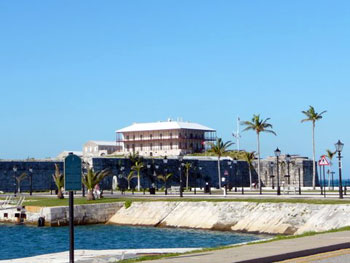
Bermuda
by Bev Lundahl
Serendipity! An invitation to Bermuda! I could continue my voyage of discovery – following the journey of the Thunderbird flying from the mast of HMCS Quesnel, the corvette that served in the Battle of the Atlantic during World War Two. This mascot written about elsewhere on this web-site (The Mystery of our History – Discovering Alert Bay) began its war service near the waters of Vancouver Island, when it was seized off the “Namgis Burial Grounds” of the Kwakwaka’wakw First Nation at Alert Bay, a village on the edge of tiny Cormorant Island. Some exuberant young sailors living in the moment that fateful year of 1942 grabbed this grave marker and ran with it. It subsequently perched high aboard HMCS Quesnel until the war’s end in 1945. One of its destinations during its perilous ocean journey had been Bermuda. Would I find any trace of its visit there on my trip – an adventure that had fallen into my lap?
Beginning its travels down the West Coast of North America from Esquimault the Thunderbird was to puff and pant through the hot humid Panama Canal and up the North American east coast finally reaching Halifax. Evolutions or war games were the reason for voyages from there to the RCN base in Bermuda. My trip to Bermuda was by air and there had been many changes during the intervening sixty-five years since the war.
Our plane swooped past St. David’s Lighthouse and landed on St. David’s Island, one of the many islands of Bermuda and home of the couple that hosted us. We were met by Lulu who drove us to her and Richard’s home nestled below an Anglican Church rising up on the hill beside their lane. Settling wearily into the comfortable chairs on their veranda we were serenaded by the strange sound of tree frogs – a sound that was constant during our time there.
 Richard, a Bermudan from many generations’ back was a gold mine of information. When I told him about my quest to learn more about the Thunderbird his face lit up as he said “You will have to go down to the dockyards. Down there on the sea wall sailors have painted images from crests of numerous ships.” The badge for HMCS Quesnel had the image of a Thunderbird on it and I could not wait to go to the dockyards. Would I really see that kind of evidence there?
Richard, a Bermudan from many generations’ back was a gold mine of information. When I told him about my quest to learn more about the Thunderbird his face lit up as he said “You will have to go down to the dockyards. Down there on the sea wall sailors have painted images from crests of numerous ships.” The badge for HMCS Quesnel had the image of a Thunderbird on it and I could not wait to go to the dockyards. Would I really see that kind of evidence there?
We wound along the long, narrow streets through the islands for an hour until we reached the tip or hook on the extreme west and north end of Ireland Island where the dockyards were located. We walked up and down questioning old sea dogs and along the way we peered at the images painted on the wall. Although we saw many designs and symbols the Thunderbird was not to be found. Since a war was being fought at the time of its abduction it was unlikely that the sailors of that era would be spending their time painting pictures.
Pursuing my interest in Bermuda military history, one of the highlights of our visit was an International Military Tattoo. Back to the dockyards where we would attend the tattoo. The dockyards had officially closed in 1951 leaving the vestiges of the old stone prison which had once held prisoners from the Boer War in South Africa and Irish prisoners that the British had shipped to the colony, the first colony of the British Empire. Two hundred years after the 1609 founding of Bermuda slave laborers and convicts were pressed into service to build in the dockyards constructing wharves, outbuildings, barracks and a massive fortified keep well stocked with gunpowder. The Commissioner’s House and the Maritime Museum held vast amounts of Bermuda’s history.
The tattoo was held in the Keep Yard of the Royal Naval Dockyard and it was a wonderful evening under the Bermuda sky. Bands from the Azores, Barbados, England, Scotland, USA and Canada performed. When the Cameron Highlanders of Ottawa marched and piped the announcer explained that this band perpetuated the 38th Battalion, Canadian Expeditionary Force, which had been in Bermuda in 1915 and 1916 during World War One and had performed at official functions there. He added that it is ‘most fitting the bands of the Guards (the Governor General’s Foot Guards in Ottawa also performed) and Cameron’s are participating in the Bermuda Tattoo 2009, commemorating the 400th anniversary of continuous settlement.’ As they piped their way out he repeated “We are so glad to have you back. We are so glad to have you back” in keeping with the spirit in their medley “Ye’ll tak the high road” “Will ye no come back again’. Quite a welcome for a Canadian visitor!
 “Was their indigenous history in Bermuda?” I wondered. Did the Thunderbird connect with First Nation’s people? I learned that Bermuda was uninhabited when the Sea Venture sailing from London wrecked there in 1609. It had wrecked on “the dreaded Bermudas, known as the ‘Isle of Devils’, supposedly inhabited by demons and evil spirits.” A sailor on the Sea Venture recorded “nothing but gusts, stormes and foule weather” and they would have avoided Bermuda “as they would shun the devil himself.” Thus the settling of Bermuda began and was followed in later years by indentured servants and slaves from Africa. The stone prison in the dockyards and exhibit at the Commissioner House of the slave trade and slavery in Bermuda tells their story. The latter is an ‘Officially Designated UNESCO Slave Route Project’.
“Was their indigenous history in Bermuda?” I wondered. Did the Thunderbird connect with First Nation’s people? I learned that Bermuda was uninhabited when the Sea Venture sailing from London wrecked there in 1609. It had wrecked on “the dreaded Bermudas, known as the ‘Isle of Devils’, supposedly inhabited by demons and evil spirits.” A sailor on the Sea Venture recorded “nothing but gusts, stormes and foule weather” and they would have avoided Bermuda “as they would shun the devil himself.” Thus the settling of Bermuda began and was followed in later years by indentured servants and slaves from Africa. The stone prison in the dockyards and exhibit at the Commissioner House of the slave trade and slavery in Bermuda tells their story. The latter is an ‘Officially Designated UNESCO Slave Route Project’.
Lulu related how the Pequot Indians had been brought to Bermuda from Connecticut and enslaved. To commemorate this history of 1637, the people on St. David’s island who are descendants of the Pequots celebrate an annual event called Schemitzun. Their lost brothers and sisters from the eastern USA join them. Part of the celebration is a POW WOW in the cricket field. The Bermuda Gombeys whose colorful regalia are reminiscent of Africa and North America’s first peoples, perform for special events and holidays portraying various roles and characters. They danced their unique step to the rhythm of drums at the Schemitzun and the history is re-lived on St. David’s Island.
 HMCS Quesnel had anchored in St. George’s harbor during part of its stay there in the 1940’s and I was anxious to go to this island in the oldest part of Bermuda. As we motored through the harbor in Richard’s boat we could see the re-enactment of the medieval dunking stool at King’s Square in sight of a replica of the Sea Venture. Like the unlucky soul who was dunked in the water from this stool we also soaked up the old history on this Island and traveled back in time.
HMCS Quesnel had anchored in St. George’s harbor during part of its stay there in the 1940’s and I was anxious to go to this island in the oldest part of Bermuda. As we motored through the harbor in Richard’s boat we could see the re-enactment of the medieval dunking stool at King’s Square in sight of a replica of the Sea Venture. Like the unlucky soul who was dunked in the water from this stool we also soaked up the old history on this Island and traveled back in time.
Further east in the harbor, we boated past Convict Bay where the Royal Canadian Navy had its base in 1944 and 1945. The British had used obsolete warships as floating prisons here in the late eighteenth and early nineteenth centuries. Hence the name Convict Bay. As we cruised by I pondered HMCS Quesnel having anchored here and its mascot’s panoramic view of this historic spot.
Nearby Fort St. Catherine’s had been used as a submarine listening post during World War Two. Bermuda, the Gibraltar of the West or the Gateway to the Caribbean had been heavily armed and well fortified and the gun at Fort St. Catherine’s Museum was evidence of this. St. George, Bermuda’s oldest town was settled in 1609 – 1610 and became a World Heritage site in 2000. St. Peter’s Church is the oldest church in the Western Hemisphere.
 We had one last stop – the grave site of Murdo Smith R.C.N.R. a commanding officer of the Quesnel. ‘Red’ Smith was a colorful Scottish Presbyterian, who was violently opposed to the Thunderbird in the mast. He considered it idol worship. He died in Bermuda two days before Christmas on December 23, 1944 and is buried at the Royal Naval Cemetery on South Ireland Island. We visited his grave site and thought about the veterans who had endured the hardships of World War Two and the Battle of the Atlantic sixty-five years ago. There are thirty-four World War One veterans and thirty-nine World War Two veterans buried there. Murdo Smith’s death was reported in The Royal Gazette and Colonist Daily, stored in The Bermuda National Public Library in Hamilton, on Wednesday, December 27, 1944.
We had one last stop – the grave site of Murdo Smith R.C.N.R. a commanding officer of the Quesnel. ‘Red’ Smith was a colorful Scottish Presbyterian, who was violently opposed to the Thunderbird in the mast. He considered it idol worship. He died in Bermuda two days before Christmas on December 23, 1944 and is buried at the Royal Naval Cemetery on South Ireland Island. We visited his grave site and thought about the veterans who had endured the hardships of World War Two and the Battle of the Atlantic sixty-five years ago. There are thirty-four World War One veterans and thirty-nine World War Two veterans buried there. Murdo Smith’s death was reported in The Royal Gazette and Colonist Daily, stored in The Bermuda National Public Library in Hamilton, on Wednesday, December 27, 1944.
The Thunderbird was captured by young sailors, who recognized the power of this symbol prevalent in North American First Nation culture – a symbol that gave them courage during The Battle of the Atlantic. Three centuries earlier the Pequots were captured and taken as slaves. Half a century later in the awakening of the new millennium the sailors and their descendents have been searching for the Thunderbird hoping to return it to the ‘Namgis First Nation’ of the Kwakwaka’wakw people. The final voyage and resting-place of the Thunderbird is still a mystery. It made many more excursions in the icy north Atlantic but where did it end up in 1945? Will another serendipity occur to bring this story to a conclusion or will the enigma of the Thunderbird endure?
If You Go:
• Air Canada Flights from Toronto to Bermuda – www.aircanada.com/en/flights/Toronto-to-Bermuda.html
• Air Canada Flights from Halifax to Bermuda – www.aircanada.com/en/flights/Halifax-to-Bermuda.html
• Royal Caribbean Cruise Line Bermuda – www.bermudacruiseguide.com/royal-caribbean.html
• Norwegian Cruise Line Bermuda – www.bermudacruiseguide.com/norwegian-cruise.html
About the author:
Bev Lundahl is a freelance writer living in Regina, Saskatchewan. Most of her writing is based on years of genealogical research. She has been published in Canada’s History Magazine (formerly The Beaver), Saskatchewan Folklore, The Heritage Gazette of the Trent Valley (Ontario), Lifestyles (Estevan Sk), and The Regina Leader Post. Her research has been referenced on CBC Radio (As It Happens), The Trident (Navy Newspaper, Halifax), The Halifax Chronicle Herald & The Victoria Times Colonist. She can be reached at bev.lundahl@accesscomm.ca
Photo credits:
All photos are by Evelyn Siegfried, Bev Lundahl, Prime Productions, Bermuda.



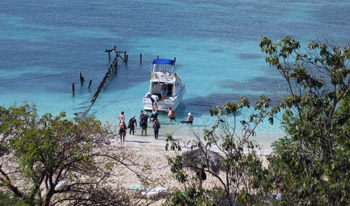 We arrived in town after a 300 km trip from Havana on our big blue and white Viazul bus. As we pulled in to the downtown bus depot we saw the usual crowd of locals there with large placards and photos, touting the virtues of their various casa particulars. While it was a tough call whether or not we should stay at any one of the hundreds of private residences, we opted this time to head out to the nearby Peninsula de Ancón, where the first new resorts were developed in Cuba following the 1959 revolution.
We arrived in town after a 300 km trip from Havana on our big blue and white Viazul bus. As we pulled in to the downtown bus depot we saw the usual crowd of locals there with large placards and photos, touting the virtues of their various casa particulars. While it was a tough call whether or not we should stay at any one of the hundreds of private residences, we opted this time to head out to the nearby Peninsula de Ancón, where the first new resorts were developed in Cuba following the 1959 revolution.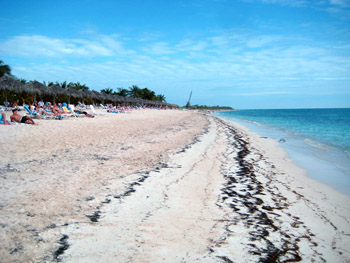 The Ancón Hotel is nothing to look at, featuring typical Russian-style architecture from the 1980s. It is fairly well-appointed inside and all-inclusivo (all food and drink included). Ask to stay in the newer part. The main dining room is where to turn up for the big buffet-style meals, and you can get nourishment anytime at an outdoor snack bar. The food is adequate but not exceptional. The old saying that ‘You don’t go to Cuba for the food’ still holds true, although things are improving as they realize the importance of the tourist peso. Like every tourist hotel, there are nightly shows at a stage near the outdoor bar, featuring a great array of talent. It makes one appreciate the high level of training for young musicians, singers and dancers in Cuba. The best feature was the Playa Ancón itself, with wide expanses of white sand and beautiful blue ocean for sunbathing, swimming, skin diving, boat trips and fishing.
The Ancón Hotel is nothing to look at, featuring typical Russian-style architecture from the 1980s. It is fairly well-appointed inside and all-inclusivo (all food and drink included). Ask to stay in the newer part. The main dining room is where to turn up for the big buffet-style meals, and you can get nourishment anytime at an outdoor snack bar. The food is adequate but not exceptional. The old saying that ‘You don’t go to Cuba for the food’ still holds true, although things are improving as they realize the importance of the tourist peso. Like every tourist hotel, there are nightly shows at a stage near the outdoor bar, featuring a great array of talent. It makes one appreciate the high level of training for young musicians, singers and dancers in Cuba. The best feature was the Playa Ancón itself, with wide expanses of white sand and beautiful blue ocean for sunbathing, swimming, skin diving, boat trips and fishing.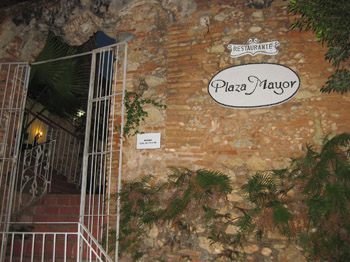 If you get tired of the beach life, it’s only necessary to hop into a cute little yellow coco cab and you’ll be in town in 10 minutes. There’s a lot to see in Trinidad: perfectly preserved churches, museums that were palaces and tenement houses that are a symbol of that Cuban region for its peculiar style. The old town architecture is neo-classical and baroque, with a Moorish flavour. Red tile roofed houses painted with pastel colors, ornamented with artistic balconies, iron wrought railings and multicolour facades. The city is very clean and well cared for. If you walk over the cobbled streets of the Trinidad, it makes you feel like going back into colonial times. A friend remarked to me that the millions of stones came from the bilges of Spanish galleons that dumped their ballast in the city and replaced it with the plunder of the new world. I wasn’t able to verify that story anywhere, but it seems possible.
If you get tired of the beach life, it’s only necessary to hop into a cute little yellow coco cab and you’ll be in town in 10 minutes. There’s a lot to see in Trinidad: perfectly preserved churches, museums that were palaces and tenement houses that are a symbol of that Cuban region for its peculiar style. The old town architecture is neo-classical and baroque, with a Moorish flavour. Red tile roofed houses painted with pastel colors, ornamented with artistic balconies, iron wrought railings and multicolour facades. The city is very clean and well cared for. If you walk over the cobbled streets of the Trinidad, it makes you feel like going back into colonial times. A friend remarked to me that the millions of stones came from the bilges of Spanish galleons that dumped their ballast in the city and replaced it with the plunder of the new world. I wasn’t able to verify that story anywhere, but it seems possible.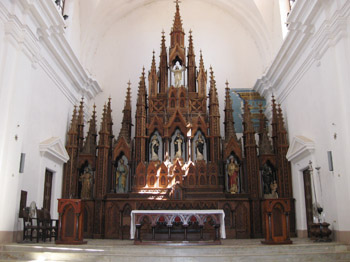 The Plaza Mayor is considered the epicentre of all things, and the eager traveller should start their walking tour there. Make your first stop the Iglesia Parroquial de la Santísima Trinidad (Church of the Holy Trinity), at the upper edge of the plaza. The city’s main church is also Cuba’s oldest. Although there has been a church on the site since 1620, construction began on the current building was completed in 1892. The interior with its 14 alters is breathtaking. A small donation is customary.
The Plaza Mayor is considered the epicentre of all things, and the eager traveller should start their walking tour there. Make your first stop the Iglesia Parroquial de la Santísima Trinidad (Church of the Holy Trinity), at the upper edge of the plaza. The city’s main church is also Cuba’s oldest. Although there has been a church on the site since 1620, construction began on the current building was completed in 1892. The interior with its 14 alters is breathtaking. A small donation is customary.
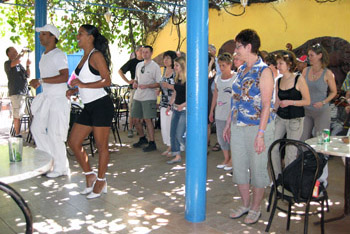 If you are into la mùsica as much as we are, there are lots of great venues de la noche to choose from.
If you are into la mùsica as much as we are, there are lots of great venues de la noche to choose from.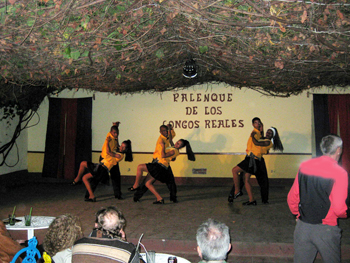 Another real find was the Palenque de los Congos Reales. This fabulous open-air nightclub specializes in performances of relatively authentic Afro-Cuban dance and music. You can always catch something spectacular there, performed by a large company of dancers, and accompanied by a big band of hot players.
Another real find was the Palenque de los Congos Reales. This fabulous open-air nightclub specializes in performances of relatively authentic Afro-Cuban dance and music. You can always catch something spectacular there, performed by a large company of dancers, and accompanied by a big band of hot players. As in all of Cuba, paladars are plentiful in Trinidad. These officially authorized restaurants in people’s homes quite often serve tastier food than you can find in any of the state run restaurants. Our favourite was the Paladar Estela. It’s hardly a secret – you can find it near the top of the list in all the guide books. You enter through an elaborately decorated colonial house with many religious objects, two blocks north of the cathedral. The handful of tables are set in an exuberant backyard garden setting, with huge numbers of flowering plants and a wall festooned with vines. Portions are nearly as voluminous as the plant life, and dishes include roast pork a la cubana, fried chicken, grilled fish, and ham omelette.
As in all of Cuba, paladars are plentiful in Trinidad. These officially authorized restaurants in people’s homes quite often serve tastier food than you can find in any of the state run restaurants. Our favourite was the Paladar Estela. It’s hardly a secret – you can find it near the top of the list in all the guide books. You enter through an elaborately decorated colonial house with many religious objects, two blocks north of the cathedral. The handful of tables are set in an exuberant backyard garden setting, with huge numbers of flowering plants and a wall festooned with vines. Portions are nearly as voluminous as the plant life, and dishes include roast pork a la cubana, fried chicken, grilled fish, and ham omelette.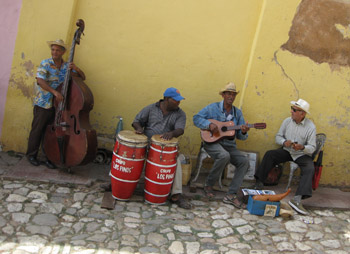 There’s a lot to see outside the city too. Be sure to make time for a trip to the Valle de los Ingenios (Valley of the Sugar Mills) to see the ruins of dozens of 19th century sugar mills located just outside the city, which are a reminder of the importance of sugar to the Cuban economy over the centuries. Other attractions include hiking in the surrounding mountains and horseback riding in the beautiful countryside.
There’s a lot to see outside the city too. Be sure to make time for a trip to the Valle de los Ingenios (Valley of the Sugar Mills) to see the ruins of dozens of 19th century sugar mills located just outside the city, which are a reminder of the importance of sugar to the Cuban economy over the centuries. Other attractions include hiking in the surrounding mountains and horseback riding in the beautiful countryside.
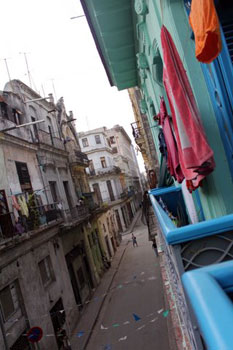 Arriving in Havana leaves even my cynical and spoiled travel mind agape. I am staying in Casco Viejo, Havana’s old town, once home to rich sugar barons and real American gangsters. The elaborate mansions built by these once-residents of Havana remain. They are dilapidated, crumbling but nonetheless majestic, echoing their former glory, like grand old dames whose jewellery has lost its gemstones and once fine clothing has become threadbare and moth-eaten.
Arriving in Havana leaves even my cynical and spoiled travel mind agape. I am staying in Casco Viejo, Havana’s old town, once home to rich sugar barons and real American gangsters. The elaborate mansions built by these once-residents of Havana remain. They are dilapidated, crumbling but nonetheless majestic, echoing their former glory, like grand old dames whose jewellery has lost its gemstones and once fine clothing has become threadbare and moth-eaten.
 If your Spanish is up to it, or if you are lucky enough to find an English speaker somewhere along the way, it is fascinating to engage in conversation with a local, to get their take on their everyday life, their current political situation and Cuba’s fascinating past.
If your Spanish is up to it, or if you are lucky enough to find an English speaker somewhere along the way, it is fascinating to engage in conversation with a local, to get their take on their everyday life, their current political situation and Cuba’s fascinating past.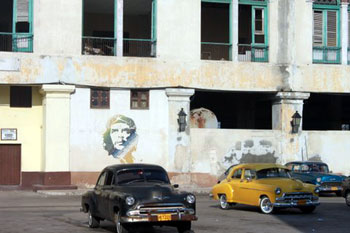 Undertones of the communist regime run throughout Havana. Some are obvious – the lines of people waiting outside the bakery to have their ration cards filled, the women approaching you on the street asking for soap or lip balm and the bare-as-a-baby’s-bottom supermarket shelves. Others you have to delve a little deeper to find – the restrictions placed on television programming, internet usage and travel for Cuban citizens, and the complete absence of any form of advertising (a fact that you may not notice until you return to a capitalist country and are seemingly assaulted with advertising virtually everywhere you look).
Undertones of the communist regime run throughout Havana. Some are obvious – the lines of people waiting outside the bakery to have their ration cards filled, the women approaching you on the street asking for soap or lip balm and the bare-as-a-baby’s-bottom supermarket shelves. Others you have to delve a little deeper to find – the restrictions placed on television programming, internet usage and travel for Cuban citizens, and the complete absence of any form of advertising (a fact that you may not notice until you return to a capitalist country and are seemingly assaulted with advertising virtually everywhere you look).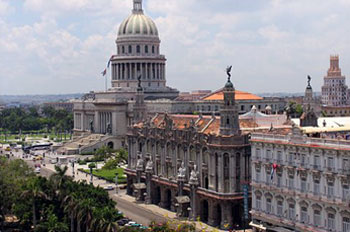
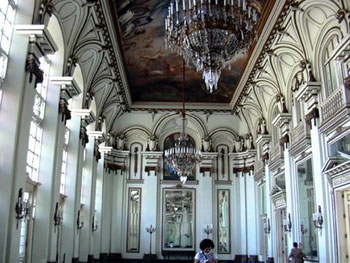 Surprise! The hype was bigger than reality! While the Cuban cuisine can hardly be described as adventurous, it was a far cry from “No hay!” I now believe there is truth in the maxim: “Tourists first – Cubans last,” but I saw little evidence where luxury goods were involved. Bathroom requisites especially, soap in particular.
Surprise! The hype was bigger than reality! While the Cuban cuisine can hardly be described as adventurous, it was a far cry from “No hay!” I now believe there is truth in the maxim: “Tourists first – Cubans last,” but I saw little evidence where luxury goods were involved. Bathroom requisites especially, soap in particular. The hub of life on the Plaza de la Catedral in the Old Quarter. The square is not large. It could be dropped without trace into most of the Revolutionary Squares which dominate Cuba’s cities and towns. The sixteenth century Cathedral has enormous character, watching over the Plaza like a hen guarding its chicks. These particular chicks are the many stall-holders who, since the communist relax, have been allowed to take on ”private enterprise” schemes [largely souvenir stalls] in an effort to aid the economy. Each stall his its own brightly coloured awning so that viewing the Square form the Cathedral steps in the dazzling light sunlight presents a feeling of looking into an emerald casket.
The hub of life on the Plaza de la Catedral in the Old Quarter. The square is not large. It could be dropped without trace into most of the Revolutionary Squares which dominate Cuba’s cities and towns. The sixteenth century Cathedral has enormous character, watching over the Plaza like a hen guarding its chicks. These particular chicks are the many stall-holders who, since the communist relax, have been allowed to take on ”private enterprise” schemes [largely souvenir stalls] in an effort to aid the economy. Each stall his its own brightly coloured awning so that viewing the Square form the Cathedral steps in the dazzling light sunlight presents a feeling of looking into an emerald casket. Also in the Square, one of Havana’s most exciting Rumba ensembles plays throughout the day at El Patio. An exciting feat for a local Cuban band that send revelers when it munched Portuguese lyrics with our English lyrics when we took together on stage in the evening.
Also in the Square, one of Havana’s most exciting Rumba ensembles plays throughout the day at El Patio. An exciting feat for a local Cuban band that send revelers when it munched Portuguese lyrics with our English lyrics when we took together on stage in the evening.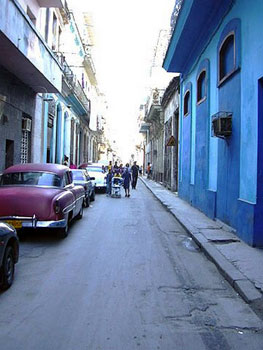 Certainly, there is a fair number of decaying crumbling once-elegant buildings. But Havana is well into a vast renovation program, thanks to the World Heritage Site claim stamped on the city by UNESCO.
Certainly, there is a fair number of decaying crumbling once-elegant buildings. But Havana is well into a vast renovation program, thanks to the World Heritage Site claim stamped on the city by UNESCO.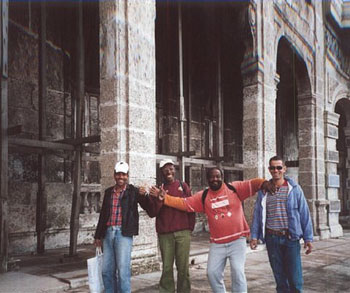 here is little evidence of Cuba’s legendary former Head of State, Fidel Castro. Far more in evidence, especially in Havana, are tributes to the American writer Ernest Hemingway who lived in the capital for over twenty years. There are statues and plaques in his honour all over the city. His house is now an intriguing Museum, almost like a shrine. Across the city, many of the writer’s ole haunts and watering holes still proudly bear his name. There is even a hotel named after his novel, El Viejo y el Mar [The Old Man and the Sea] where we stayed for several nights. Prices ere quite reasonable – but still beyond the average Cuban’s income.
here is little evidence of Cuba’s legendary former Head of State, Fidel Castro. Far more in evidence, especially in Havana, are tributes to the American writer Ernest Hemingway who lived in the capital for over twenty years. There are statues and plaques in his honour all over the city. His house is now an intriguing Museum, almost like a shrine. Across the city, many of the writer’s ole haunts and watering holes still proudly bear his name. There is even a hotel named after his novel, El Viejo y el Mar [The Old Man and the Sea] where we stayed for several nights. Prices ere quite reasonable – but still beyond the average Cuban’s income.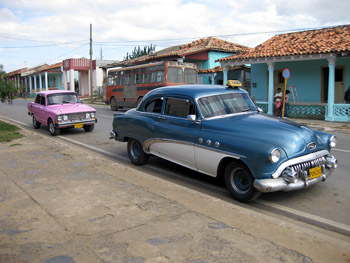
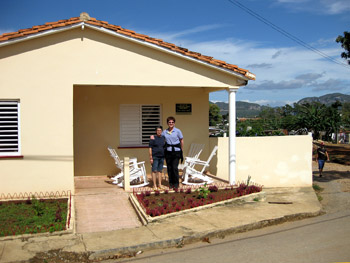 The words of our friends reverberated in our heads as our big Viazul bus pulled into town. The usual crowd of entrepreneurs pressed up against us as we disembarked, most wanting to take us back to their casa particular for accommodation. We already had the name and address of one that we hoped to stay at, so we fought our way through the hordes and made it to the office of the local cab company. Upon arriving at our destination, we found that the house was already occupado. Not to worry – we were introduced to Yiya, who happened to be walking by. Before we knew it, her Casa Candelaria Negrin (House of the Black Candle) was our home away from home for the next few days.
The words of our friends reverberated in our heads as our big Viazul bus pulled into town. The usual crowd of entrepreneurs pressed up against us as we disembarked, most wanting to take us back to their casa particular for accommodation. We already had the name and address of one that we hoped to stay at, so we fought our way through the hordes and made it to the office of the local cab company. Upon arriving at our destination, we found that the house was already occupado. Not to worry – we were introduced to Yiya, who happened to be walking by. Before we knew it, her Casa Candelaria Negrin (House of the Black Candle) was our home away from home for the next few days.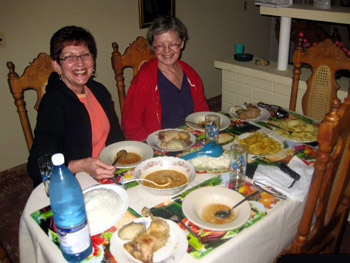 There’s always a bit of a sense that the casa hosts want to keep a bit of distance from you. They generally eat separately, or at a different time, and they usually have separate living quarters. It’s understandable … you are invading their home. Don’t get the wrong impression, though. Yiya and her family were friendly, hospitable and as informative as they could be, given the language difference!
There’s always a bit of a sense that the casa hosts want to keep a bit of distance from you. They generally eat separately, or at a different time, and they usually have separate living quarters. It’s understandable … you are invading their home. Don’t get the wrong impression, though. Yiya and her family were friendly, hospitable and as informative as they could be, given the language difference! The area is a magical terrain of hills and caves where life centres on growing tobacco. Farmers, most of who came from the Canary Islands, arrived around 1800 and began cultivating tobacco across the region. Two hundred years later, the tobacco grown in the distinctive red soil of the area is still the lifeblood of the Viñales Valley. Only the best leaves get sent to Havana, where hundreds of workers called torcedores or anilladores hand roll them into cigars. Cuba still produces 65 million cigars a year, packed in cedar boxes and exported world-wide.
The area is a magical terrain of hills and caves where life centres on growing tobacco. Farmers, most of who came from the Canary Islands, arrived around 1800 and began cultivating tobacco across the region. Two hundred years later, the tobacco grown in the distinctive red soil of the area is still the lifeblood of the Viñales Valley. Only the best leaves get sent to Havana, where hundreds of workers called torcedores or anilladores hand roll them into cigars. Cuba still produces 65 million cigars a year, packed in cedar boxes and exported world-wide. One of the more interesting attractions in Viñales is the little Casa de Caridad Botanical Gardens located at the north-eastern end of town. Started many decades ago by two sisters, their descendants are now running the gardens. The lush gardens in the sizable back yard feature a mix of ornamental and medicinal plants and flowers, as well as palm and fruit trees. Adding to the curious nature of the grounds are homemade decorations like heads ripped off dolls hanging everywhere. The Miranda sisters were well-known practitioners of voodoo back in the day. No admission is charged, but a 1 CUC donation is warmly appreciated.
One of the more interesting attractions in Viñales is the little Casa de Caridad Botanical Gardens located at the north-eastern end of town. Started many decades ago by two sisters, their descendants are now running the gardens. The lush gardens in the sizable back yard feature a mix of ornamental and medicinal plants and flowers, as well as palm and fruit trees. Adding to the curious nature of the grounds are homemade decorations like heads ripped off dolls hanging everywhere. The Miranda sisters were well-known practitioners of voodoo back in the day. No admission is charged, but a 1 CUC donation is warmly appreciated. Music is in the Cuban people’s DNA. Almost every restaurant, coffee bar and nightclub in Viñales offers great entertainment. Given the rural nature of the area, the music is different from that in the big cities like Havana and Santiago de Cuba. On our first night, we ended up in an open air night club called Polo Montanez Centro Cultural. For a 3 CUC cover, we were treated to traditional groups, a contemporary salsa band, singers, dancers, fire-eaters and more!
Music is in the Cuban people’s DNA. Almost every restaurant, coffee bar and nightclub in Viñales offers great entertainment. Given the rural nature of the area, the music is different from that in the big cities like Havana and Santiago de Cuba. On our first night, we ended up in an open air night club called Polo Montanez Centro Cultural. For a 3 CUC cover, we were treated to traditional groups, a contemporary salsa band, singers, dancers, fire-eaters and more! Regretfully, we were only in Viñales for a few days. It wasn’t nearly long enough to see all the sights. We didn’t get to the horseback riding, caving, hiking or bird watching. There are also magnificent beaches to the north, less than an hour’s drive away. We hope to go back again soon, take our bicycles, and spend at least a week there. Sleepy old Viñales is full of warm, friendly people, enchanting adventures and breathtaking sights. Similarly to those folks who said it to us, we now say to you, “Just GO! You won’t regret it.”
Regretfully, we were only in Viñales for a few days. It wasn’t nearly long enough to see all the sights. We didn’t get to the horseback riding, caving, hiking or bird watching. There are also magnificent beaches to the north, less than an hour’s drive away. We hope to go back again soon, take our bicycles, and spend at least a week there. Sleepy old Viñales is full of warm, friendly people, enchanting adventures and breathtaking sights. Similarly to those folks who said it to us, we now say to you, “Just GO! You won’t regret it.”
